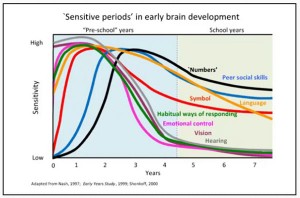1.2 Experience-based brain development

Experience-based brain development in early life (including during gestation) can set trajectories for life-long health, learning, and behaviour and is often difficult to change later in life.
Experiences obtained early in life turn on genetic pathways that discern neuron function as well as establishes neural pathways. Experiences also affect the formation of synapses (connections) among neurons.
Experience-based brain development is the concept that experience shapes the way the brain and other biological systems develop. We have known for a long time that physical experiences such as nutrition are important for early brain development. We now understand that other aspects of experiences and the environment such as social interactions (i.e., warm and responsive interaction between caregivers and children) and early adversity are also profoundly important and have long-lasting effects on brain, behaviour and health.
In the next video, Dr. Joel Levine, professor of Ecology and Evolutionary Biology at the University of Toronto, explains the term experience-based brain development.
Listen to Dr. Rob Santos, a psychologist and research chair of the Early Childhood Development Research team at Red River College Polytechnic, discuss early brain development and experience.
Santos discusses the importance of supporting pregnant women. In what ways could providing support to a pregnant woman influence brain development of the fetus?
Santos also says that the social environment of the child is very important to early brain development. What does this mean? What do you see as a supportive social environment for a young child?
There are two distinct ways that experiences impact brain development – experience-expectant and experience-dependent processes. Listen now as Dr. Maureen Black, professor of Pediatrics at the University of Maryland, describes these two processes.
It is clear that brain development does not happen independent from one’s environment. Listen as the late Sir Michael Rutter, formerly at King’s College London, reviews different ways that environments and experiences influence brain development and adaptation.
Rutter refers to Hubel and Wiesel’s studies of visual cortex development. Would this be categorized as an experience-expectant or experience-dependent process?
What about the example of early life language discrimination – is that an experience-expectant or -dependent process?
Dr. Charles Nelson, Harvard Medical School, describes how facial recognition is an example of experience driving brain development in infancy.
Some of what is known about how people recognize faces comes from patients who have suffered a brain injury that results in Prosopagnosia, which is the inability to recognize others by their faces alone. The next reading explains this syndrome and the neural mechanisms of facial processing.
Nature through nurture
What if experiences of joy, sorrow, love, fear and loneliness leave an imprint on the cells and nerves in an infant’s body? What if our early social interactions affect the way our genes express themselves? What if an emotionally nurturing environment is as important to physical development as good nutrition? A mounting body of evidence suggests that our first experiences in the world play a much larger role than anyone thought in their physical health and development. This evidence shifts the nature versus nurture debate” (Barr, 2006, p.1).

Every child is unique; even two children of the same biological parents with seemingly very similar upbringings can be very different from one another both genetically and with regards to their environmental experiences. For example, children may differ in their birth order (i.e., a child may be a first born and therefore only has the experience of having younger siblings, while a middle child has the experience of having both older and younger siblings) and sex. They may also differ in their temperaments and physical appearances; all these contribute to how the environment may respond to them or how they may respond to their environment. In an attempt to answer how this is so, people have debated the importance of nature vs. nurture for years. Nature refers to our genetic make-up; nurture refers to environments and experiences. Are genetic or environmental factors more important in determining child outcomes?
Dr. Marla Sokolowski, University of Toronto, explains that the phrase, “nature versus nurture” is no longer applicable to scientists’ understanding of how human beings develop.
In the next video, Dr. Thomas Boyce, pediatrician and distinguished professor emeritus in the Departments of Pediatrics and Psychiatry at the University of California, San Francisco, explains the nature-nurture relationship with his concept of symphonic causation. He discusses the idea of nurture working through nature to lead to healthy or unhealthy outcomes. He suggests that we can separate nature from nurture about as usefully as we can separate rhythm from melody in describing a song. He maintains that each is essential. As it is the details of how they work together that matters, he proposes the whimsical term “symphonic causation”.
The following activity will give you a chance to explore information related to Boyce’s concept of symphonic causation. Each time you find two matching pictures, an interesting fact will appear.
Consider these examples of nature through nurture:
A child may have a genetic predisposition to burn when exposed to the sun. However, if that child lives in a climate with little sun exposure or always wears sunscreen and protective clothing, s/he likely will never have sunburn. This may then offer protection against skin cancer later in life.
Children may be genetically predisposed to be tall in adulthood. However, without proper nutrition through infancy and childhood, they may not reach their full growth potential.
Identical twins who share the same genes develop differently due to dissimilar experiences. These experiences in turn result in different gene expressions.
Sensitive periods
In this KidCareCanada video, Dr. Boyce starts by saying it is important to “…hold, talk and touch to babies…” As he relates this to brain architecture, he introduces the concepts of critical and sensitive periods.
It is important to understand the nature of sensitive periods, especially when considering how to support optimal development. A sensitive period is a period of time in neural circuit development where experience strongly influences how the circuit is constructed. This slide illustrates this concept by showing how the formation of synapses for different neural pathways takes place at different times. For example, the sensitive period of development for vision (and when we see the highest amount of synapse formation) occurs prior to the sensitive period for peer social skill development. Click on the slide to have a closer look.
In the next clip, the late Dr. Clyde Hertzman, founding director of the Human Early Learning Program (HELP) at the University of British Columbia, discusses the overall effect that early childhood conditions have on healthy life course development. He adds to our understanding of sensitive periods in the developing brain by describing some of the basic competencies young children need to develop and the adult responses that facilitate children developing these competencies.
Hertzman describes that because of early brain sensitivity, early environments should be nurturing and rich in language stimulation. Do you think there is general awareness in society about this? If not, can you think of ways to get this message out?
In the following clip, neuroscientist Dr. Bryan Kolb, University of Lethbridge, discusses brain development in the context of sensitive periods.
As Kolb says, in common usage, the terms sensitive period and critical period are sometimes used interchangeably, but there is a distinction between the two. The next reading explains these two terms.
Brain plasticity is the brain’s capacity to change in response to experiences. The next video is from the documentary, The Beginning of Life. It explains that the plasticity of the developing brain brings opportunities and risks.
In the next clip, Kolb explains why brain plasticity and synaptic development decrease with age.
As Kolb says, early brain development is for the long term. The brain’s architecture and the child’s skills are built from the bottom up. Each stage of brain development rests on another. Neural circuits that process basic information, such as sights, sounds and touch, or govern basic functions, such as breathing, are wired before those that process more complex information. Neural pathways for reading or solving abstract problems build on earlier pathways for vision, hearing or touch, just as children’s skills build on earlier skills. Neural pathways may adapt and change over time, but their basic early structure stays with us for life.
The next clip shows seven-month-old Lucy being fed cereal by her mother.
How does Lucy’s mother show she understands Lucy’s social signals? How does Lucy communicate?
What sensory pathways do you think are being stimulated? Check the slide above on sensitive periods. In what areas is Lucy especially ready to learn?
The evidence is clear that early child development is a period of opportunity to establish a sturdy neural foundation for later development. It is also a period of increased risk that can compromise development for life.
Use the flash cards below to review some key terms from this section before going to the next section in this module.






